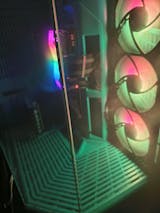Whether you work from home or you’re a casual after-hours warrior in the gaming world, there’s no more rewarding experience than building your own computer. You’ll soon realize, if you haven’t already, that cable management can quickly become a time-consuming and tedious task. Computers require a wide variety of cables to connect one core component to the next. Cable management has some obvious and not-so-obvious benefits, such as improved speed, efficiency, bandwidth, performance, and uptime, all whilst reducing your carbon footprint and energy usage overall. If you’ve finally decided to address the rat’s nest in your rig, our helpful guide to cable routing is a great place to start.
Beginner’s Guide to Cable Routing
1. You can easily save time and energy on organizing by mounting all your cables to a piece of pegboard. PC enthusiasts often employ wires or cable ties to keep their cords clean and easily discernable.
2. With the help of wire baskets, you can get all your important cables off of the floor to free up valuable floor space beneath your workstation. Decluttering is easy with the help of cable ties.
3. If you’re looking for an affordable way to keep power plugs from falling, your solution may be hidden with the rest of your office supplies. Binder clips work well to keep power plugs attached to the back of your desk.
4. Listening to music while you work or play your favorite PC games? Keep your earbuds tangle-free and easily accessible by wrapping them around your iPod, MP3 player, or tower speaker.
5. Another affordable solution to keep extension cords tangle-free may be hidden in your recycle bin or trash can. Paper towel tubes are compact and will keep your extension cords manageable.
6. Foam pipe insulation is another creative solution to hiding cable messes. After cutting the insulation to size, just slice down the length of the insulation and stow your cables inside, pulling out each end through the slit.
7. With so many gadgets to charge on a daily basis, you may benefit from building your own charging station. Using a small bedside table, toolbox, or memory dock box, you can build a comprehensive charging station that can also hide your cables in a stylish way.
8. Trade in your plastic cable ties for reusable cable ties that can be daisy-chained, undone, and refastened. Heavy-duty cable ties come in a variety of sizes to suit any need.
9. Are you constantly tripping over extra-long cords? Solve your troubles with a little DIY. Lengthy cords can be organized with handmade cord wrappers. Just use a rubber mat, credit card, or coin wrapper to get started.
10. Trying to determine one power plug from the next can be a painstaking process. Work smarter, not harder, by cataloging your plugs with labels or stickers.
Proper PC cable management is an essential responsibility of any computer enthusiast. Cable routing does require a keen eye, patience, and the right components.
Your cart is currently empty.
Start Shopping












